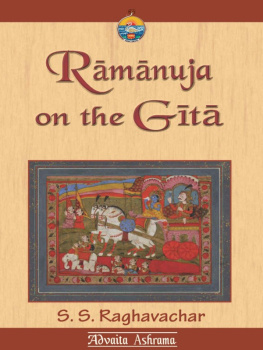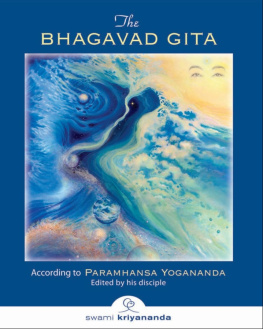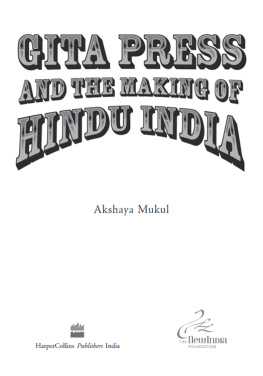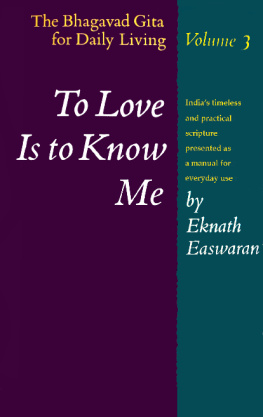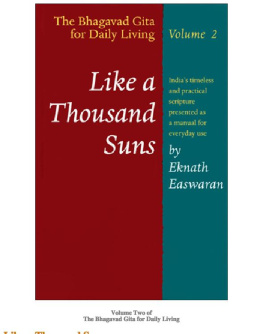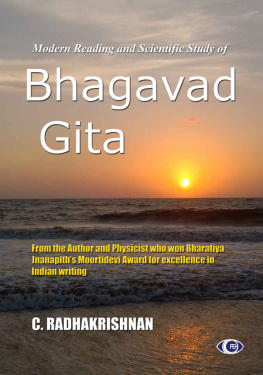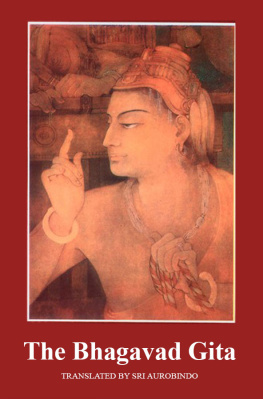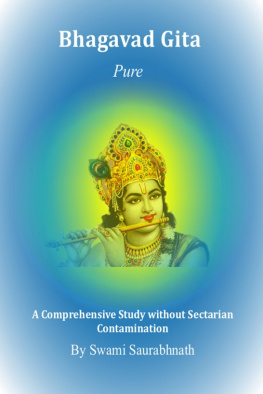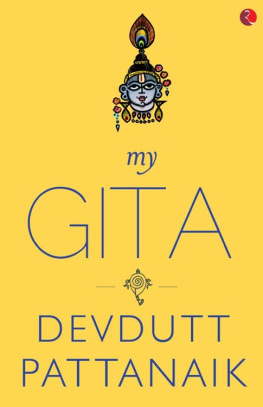R m nuja
on the G t
S. S. Raghavachar
(P UBLICATION H OUSE OF R AMAKRISHNA M ATH )
5 D EHI E NTALLY R OAD K OLKATA 700 014
Published by
The Adhyaksha
Advaita Ashrama
P.O. Mayavati, Dt. Champawat
Uttarakhand - 262524, India
from its Publication Department, Kolkata
Email: mail@advaitaashrama.org
Website: www.advaitaashrama.org
All Rights Reserved
Fourth Edition, January 2017
First Ebook Edition, October 2017
ISBN
978-81-7505-120-1 (Paperback)
978-81-7505-887-3 (Ebook)
PUBLISHERS NOTE TO THE FOURTH EDITION
We are pleased to present this digitally composed version of the Rmnuja on the Gita as a new edition. The whole text has been thoroughly rechecked and appropriate corrections made. We hope the readers would welcome this edition.
P UBLISHER
12 January 2017
PUBLISHERS NOTE TO THE THIRD EDITION
The commentaries upon the Gita are numerous. Each school of philosophy in India has found in it the source of its metaphysical system, and from it every philosopher or saint has drawn inspiration. So the Gita contains the germs of all forms and systems of Indian religious thought, but it cannot itself be limited to any particular system of metaphysics or religion. For it is not a metaphysical treatise, nor is it the fruit of the traditional religious thinking of any particular sect, one should say, it contains metaphysical truths in their diverse aspects, and embodies every form of religious thought, practice, and discipline.
In the present book Prof. S. S. Raghavachar has presented in a masterly way the commentary of r Rmnuja on the Gita.
This book has already undergone two editions, both published by r Ramakrishna Ashrama, Mangalore. In publishing this third edition, we wish to express our profound gratitude to them for making available the copyright of this book.
P UBLISHER
Advaita Ashrama
Mayavati, Himalayas
28 November 1990
FOREWORD
This is an important and impeccable book written with singular conviction and remarkable ability since the lectures on the Gt by r M. Rangacharya were published. In the essays embodied in this book, Prof. S. S. Raghavachar closely follows r Rmnujas com-mentary on the Gt . r Rmnujas commentary on the Gt is a Bhya, not a Vykhyna or Vtti. As such he gives the connection from verse to verse, from chapter to chapter and from atka to atka. The author brings out all these in a conspicuous manner.
The Gt presents the tenet that r Ka is the Supreme Person, an Avatr of the Absolute into the world of men. From times immemorial generations of men and women have turned to the Gt for the solution of their personal dilemmas. The Gt affirms the psychological paths of Karma, Jna and Bhakti for the solution of the problems of life. The process of ascent is from Karma to Jna, from Jna to Bhakti. Karma is selfless work without the desire that prompts it normally. Work done in this way stimulates the power of knowledge. Jna is the realisation of the self as different from the modes of matter. This discipline prepares the ground for Bhakti. Bhakti is the approach through Love to the Supreme Person. The votaries of Ka enter His being, the Supreme Abode. Thus the Gt affirms the reality of a personal God, the ground and the goal of human existence.
The author presents clearly and concretely the comprehensive ideal of Gt with insight, vision and authority. This is a distinct contribution to the Gt literature.
Swami Adidevananda
PREFACE
Convinced, as I am, that the best writing on the Gt is to be found in the traditional commentaries, I offer this brief exposition of the Gt-Bhya of Rmnuja. This particular interpretation has not entered into the modern understanding of the Gt , as much as it ought to. The modern student of the Gt lacks the requisite data in English as r Govindchryas complete translation has ceased to be available and Dr. Van Buitenen has given only a condensed version. I am trying the experiment of presenting the substance of Rmnujas great treatise, duly fulfilling the twin requirements of economy and fidelity and carefully focusing on the basic and distinguishing contributions of the charya. Close correspondence with the original is maintained and in crucial contexts the exposition does the work of a translation as well. The abundant elucidation furnished by Vednta Deika is utilized throughout. It is hoped that this new manner of reproducing the rich and profound vision enshrined in the Bhya will succeed.
It is in the fitness of things that the work is sponsored under the auspices of the r Rmaka rama, Mangalore, where all my major writings took shape under the inspiring guidance of Swami Adidevananda and the gracious encouragement of Swami Vijnananda and Swami Sundananda. I thank the Swamiji for his benedictory Foreword.
r Achyut Kamath of the Sharada Press, justly famous for its fine work, is the main architect of this project and all the credit for this publication goes to his generous zeal and enlightened devotion. One cannot thank him enough.
Let me conclude with the apt prayers of r Vednta Deika:
:
: :
S. S. Raghavachar
KEY TO TRANSLITERATION AND PRONUNCIATION
Sounds like
a
o in s o n
a in m a ster
i
i in i f
ee
in f ee l
u
u in f u ll
oo in b oo t
somewhat between
r and ri
e
a in ev a d
ai
y in m y
o
o in o ver
k
k
kh
ckh in blo ckh ead
g
g (hard)
gh
gh in log- h ut
ng
v
ch (not k)
ch
chh in cat ch him
j
j
jh
dgeh in he dgeh og
n (somewhat)
t
h
th in an t-h ill
d
h
dh in go dh ood
n
n in u n der
t
French t
th
th in th umb
d
d in th em
dh
theh in brea the here
n
n
p
p
ph
ph in loo p-h ole
b
b
bh
bh in a bh or
m
m
y
r
r
l
l
v
v in a v ert
sh
sh in sh ow
s
s
h
h
.
m in hu m
:
half h in hu h !
CONTENTS
Rmnuja (1017-1137 CE)
INTRODUCTION
G ENERAL S URVEY OF M ODERN W RITINGS ON THE G T
To attempt a fresh interpretation of the Gt in the present state of Indian scholarship may appear somewhat superfluous and may at best be construed a mere act of piety. But a rough survey of the kind of writing that has filled the field will modify the impression. It is worthwhile classifying the literary productions of modern writers on the Gt . There is in the first place a considerable body of writing dealing with the text of the Gt in the spirit of Indology. This class of writing deals with the age of the present text, and its homogeneous or heterogeneous character, tackling the question whether it is a composite product brought into its present shape by successive additions to a primitive and simple core, and on the latter hypothesis attempts the reconstruction of that core and the characterization of the major additions. Incidental to this type of analysis is the consideration of the question of the place of the Gt in the Mahbhrata , whether it is a later addition to the old epic narrative or an integral and central expression of the philosophical wisdom of that vast epic. Much labour of research and exercise of historical fancy have gone into this class of writing on the Gt . This Indological approach hardly leaves room for a consideration of the philosophical substance of the work as we find it. Therefore the question of the evaluation of the Gt as a philosophical work does not arise. There is another type of writing on the Gt which, in bulk and popularity, is by no means lesser. This is marked by the spirit of faith and approaches the Gt as the supreme gospel of spiritual wisdom. We have simple translations and condensations of the lines of moral and religious guidance embodied in the work. The metaphysical and ethical questions treated in the Gt are not handled with any thoroughness and rigour and the intention to distil the quintessence of the prescription of the Gt for the practice of the higher life is the dominant one. The Indological outlook is set aside and the traditional view of Hinduism concerning the text is adhered to. Knotty issues in interpretation are solved with the aid of some traditional commentaries, mostly the one by ankara. There is neither the passion for scholarship nor the effort at rethinking. This is a simple view of the Gt as the supreme scripture and the attempt is to appropriate it as such.
Next page
